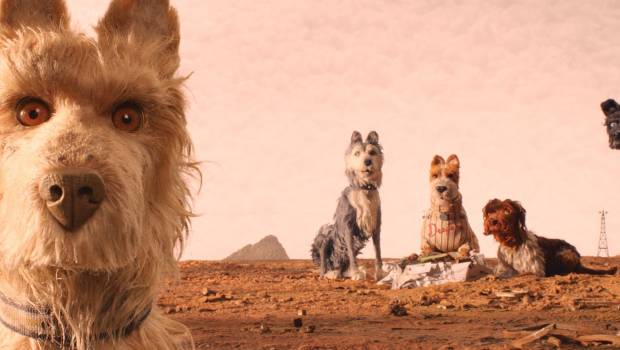Isle of Dogs – Film Review
Reviewed by Damien Straker on the 21st of April 2018
Fox presents a film by Wes Anderson
Produced by Wes Anderson, Scott Rudin, Steven Rales and Jeremy Dawson
Screenplay by Wes Anderson and story by Wes Anderson, Roman Coppola, Jason Schwartzman and Kunichi Nomura
Starring Bryan Cranston, Edward Norton, Koyu Rankin, Bill Murray, Jeff Goldblum, Bob Balaban, Kunichi Nomura, Ken Watanabe, Greta Gerwig, Frances McDormand, Scarlett Johansson, F. Murray Abraham and Liev Schreiber
Music by Alexandre Desplat
Cinematography Tristan Oliver
Edited by Ralph Foster and Edward Bursch
Running Time: 101 minutes
Rating: PG
Release Date: the 12th of April 2018
Different is too simple a description for Wes Anderson and the highs and lows of his filmography. Few others in Hollywood have admirably dedicated themselves to being as consistently unique and offbeat as this peculiar filmmaker.
Yet this resistance to conformity has sometimes caused the director to stumble. Anderson’s films have often been overly quirky or gimmick-laden as reminders of his stylistic imprint or personality rather than as a service to his narratives.
Fortunately, Isle of Dogs, a stop-motion animated production, is one of his best films. Its world feels logically constructed and it is surprisingly made with restraint. The script is also very funny, and perpetually comments on fascism, propaganda and government corruption. It is strange and off-beat but mostly a success through the delicate craft Anderson showcases.
The story details the history of a war between cats and dogs, where dogs were considered pests in Feudal Japan. In the future, the anti-dog dynasty is continued by Mayor Kobayashi (Kunichi Nomura). This wicked man runs Megasaki City and passes a decree deporting the dogs to Trash Island. The government argues they’ve been infected with dog flu disease to justify their exodus.
On Trash Island, the main dog pack includes Chief (Bryan Cranston), Rex (Edward Norton), Duke (Jeff Goldblum), Boss (Bill Murray) and King (Bob Balaban). Everyone works together except Chief, who insists that he can’t be patted and that he bites. He purports a tough demeanour, arguing that unlike the other house dogs that he is a stray, and that he has a violent past.
The group dynamics transform once a plane crashes unexpectedly onto the island. The pilot is a young boy named Atari (Koyu Rankin), who is Mayor Kobayashi’s nephew. He is looking for his dog Spots (Liev Schreiber). Meanwhile, Megasaki’s scientists try unsuccessfully to convince Kobayashi that the dog flu can be cured. Their only ally is Tracy (Greta Gerwig), an American student activist from Ohio who works tirelessly to uncover the truth about the government.
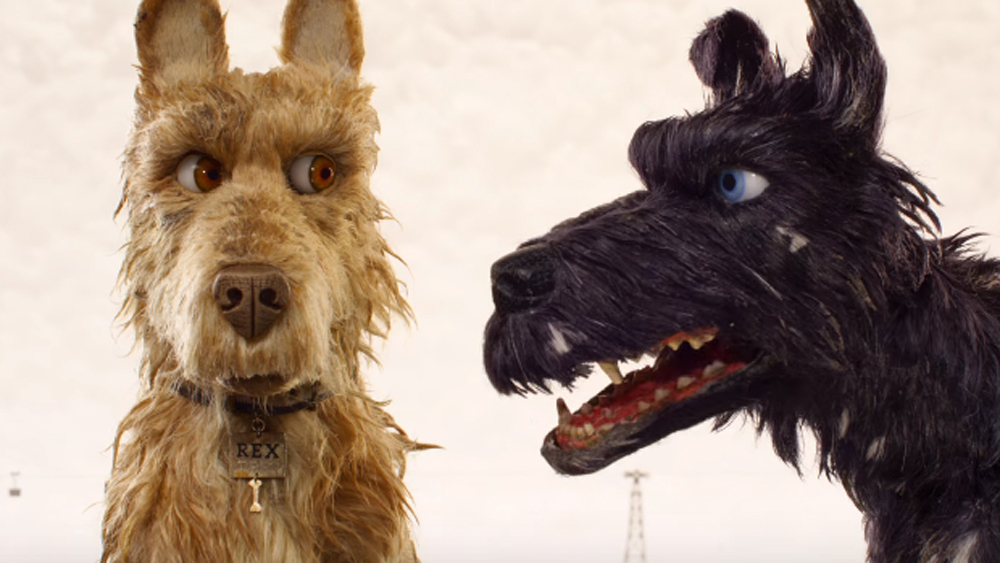
Many of Wes Andersons films have encompassed deliberate visual symmetry to ensure that the images, camera shots and actions are continually synchronised in movement. His second foray into stop motion animation, after Fantastic Mr. Fox (2009), continues to solidify his understanding of this unique symmetrical form.
Stop motion animation is slower and more stilted than CGI. Every movement or action must be delicately planned. The slower tempo arranges the film’s action into symmetrical lines. For example, on a world map a line is drawn from the city to the island, and mechanical cranks move up and then sideways before dropping the dogs onto the ground. The precision of the images and their structured movements reflects the film’s concerns about the power of the industrialised world displacing living matter.
A scene where the dogs work together to rebuild Atari’s plane shows how the symmetrical form represents character. Most of the dog pack and Atari are positioned on a beam together. Through several frames, the camera crabs sideways to show Chief hiding from them, pretending to dig. The horizontal movement of the camera reflects his emotional distance from their class.
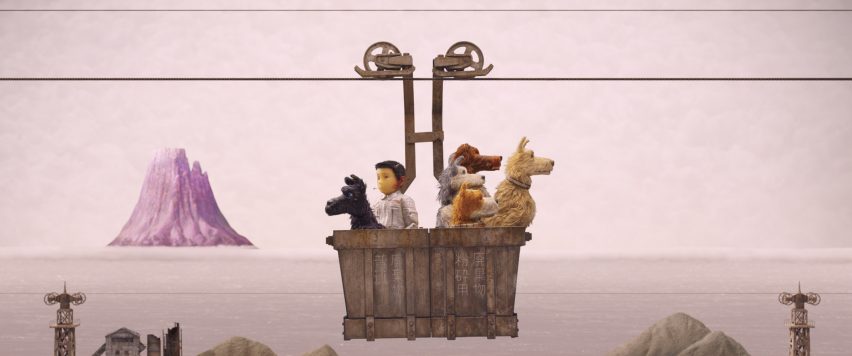
The dogs moving in a pack or aligning in formation to fight become repeated visual images that pair well with the symmetrical form. The visual grammar outlines Anderson’s arching thematic goal, where animals, people and foreign cultures deserve equality and to find love in the face of fascism. One of the characters asks: “What happened to man’s best friend?”
The film is loaded with visual gags, some of which would remain hidden after consecutive viewings. Evidently, the filmic style represents the over-the-top nature of Japanese cartoons and their use of killer robots. There is also an emphasis on small, pivotal details. The emotional reactions of the characters substitutes dialogue (there are no subtitles for some of the Japanese lines), and there are hilarious gag shots too, including a ‘you must be this tall’ samurai sign, a dog casually reading a magazine next to a radiator, and a parody of Hokusai’s famous print image ‘The Great Wave off Kanagawa’.
Anderson has smartly emphasised the island’s damaged ecology, including large amounts of vermin and disease on the ground. The rats, garbage and the muted colours of the landfill add grittiness and texture to the landscape. Similarly, the wide shots of the ruined factories, powerplants and the sports centre become powerful reminders of the devastation of climate change, and real-world disasters. The Fukushima nuclear disaster, which involved the government suppressing information, is a major reference point for the narrative and its visual style.
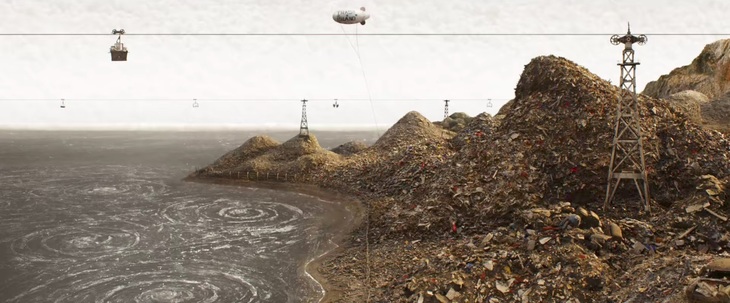
Some have argued that Anderson is racist for utilising stereotypes to depict Japanese culture. However, Isle is arguably about contemporary America as much as Japanese culture. It’s his second attack on fascism after The Grand Budapest Hotel (2014), which alluded to Nazism. The film parallels how climate scientists have been marginalised by the Trump administration. There is even a scene where Kobayashi summons a big red button, which is a hilarious mirror of Trump touting the size of his button on Twitter.
The cultural references, including sumo wrestling and sushi, are either very slight or pivotal to the plot that they resist feeling superficial. The decision to not include subtitles for the Japanese characters has also been deemed insensitive. However, it is a deliberate stylistic choice that reflects the emotional distance between humans and dogs that must be bridged. The Asian characters also have the most agency in the story’s climax, which dispels the idea that they are marginalised or that Tracy is the film’s white saviour.
Further, there’s even unexpected character development for one of the villains, which further reduces the stigma of stereotypes. Meanwhile, Alexandre Desplat’s powerful Japanese-inspired score, performed on drums, is a memorable inclusion. Anderson respects the score by only using one effective 1960s ballad, ‘I Won’t Hurt You’ by The West Coast Pop Art Experimental Band.
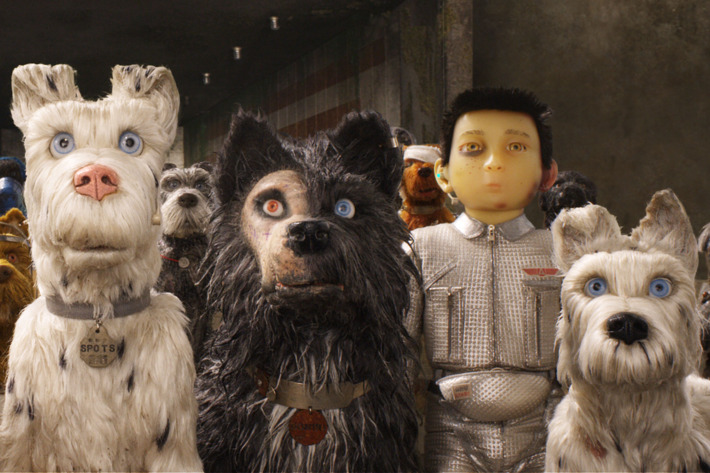
Isle is also an exploration of loyalty through several shifting alliances. The most poignant example is the relationship between Chief and Atari. There are some sweet, gentle scenes that build growth in the characters, such as when Chief receives a puppy snack for the first time and a bath. The fact that Anderson can draw poignancy out of stilted animated dogs reflects his control over the story.
One of the film’s best scenes reflects the deftness of the comedy and the emotion discovered by the voice actors. Chief tries approaching a female dog named Nutmeg (Scarlett Johansson). He stumbles badly, insulting her about being with another dog. He then apologies and starts over, realising he’s hurt her feelings. As they bond over the night sky, she reveals to him how she wouldn’t bring puppies into the world and instructs him he to find Atari’s dog.
There’s no overstatement or winking with the scene’s black humour. The way the dynamics of the conversation are shot and edited and how it instils feelings into the characters is strategically planned. The nuance cements Anderson’s aim of drawing parallels between people and animals as valuable living creatures both rediscovering the meaning of love. The cleverness and the charm of the world means we sometimes forget we’re watching talking animals, which is a major attraction of this unique and sometimes hilarious animated feature.
Summary: The cleverness and the charm of the world means we sometimes forget we’re watching talking animals, which is a major attraction of this unique and sometimes hilarious animated feature.

